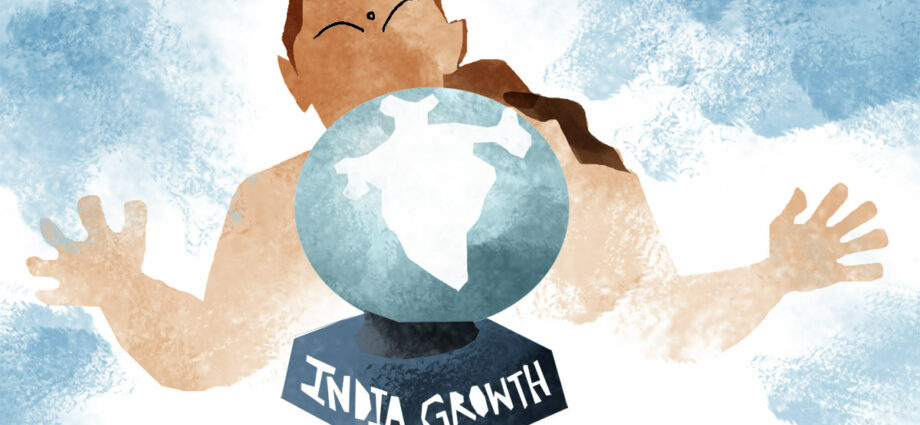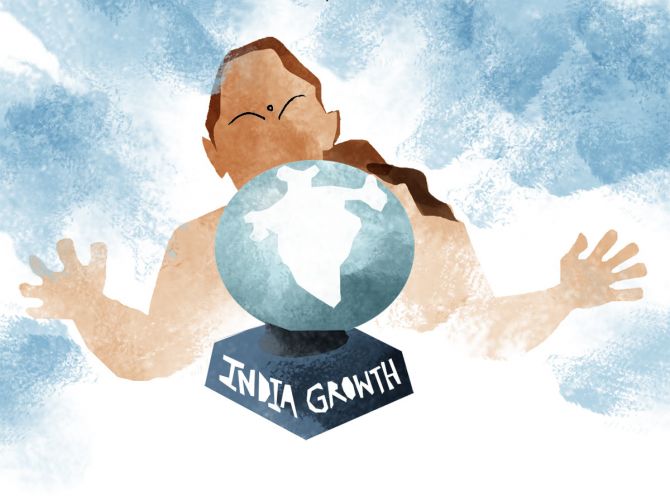‘The government should act proactively to instil confidence in private investors, and also boost the purchasing power of people directly or indirectly by ensuring minimum wages.’
Recently released data on India’s economic growth by the National Statistical Office revealed that India’s economic growth decelerated to 4.4% in the October-December 2022 quarter.
Former RBI governor Dr G Raghuram Rajan warned that India was dangerously close to the Hindu rate of growth of 4%.
Are we really going in that direction? Shobha Warrier/Rediff.com asks Dr Surajit Das, assistant professor of economics, Jawaharlal Nehru University.
“If the global recession continues, if there is a limited possibility of having an export led growth, and if the government also doesn’t do anything to compensate for that loss, then there is a possibility that our growth rate would come down to Hindu rate of growth,” Dr Das explains in the concluding segment of a two-part interview:
- Part 1: Why India’s Growth Rate Has Suffered
Zero income? How does it happen?
That is when you look at unpaid family labour. In agriculture, all the family members contribute but all of them do not get paid.
The concept of employment has to be linked with income. Otherwise, in a country like ours, we would not get the real picture.
According to the latest Periodic Labour Force Survey’s weekly status report, the unemployment rate has come down substantially.
But if you look at the way they have calculated the definition of unemployment, you will see that it says if you get one hour of employment in any of the days in last 7 days, you would be considered employed.
If you set the bar at let’s say 5 days a week of employment and at least 4 hours in a day, then your unemployment rate even before the lock-down, would become around 20%.
It increased to more than 40% during the first quarter of lockdown. This is the reality.
Many surveys have found that rural unemployment is rising. Why?
Even now, 50% of the labour force in rural areas is dependent on agriculture, directly or indirectly, for their livelihood.
They are involved in other activities too, like working in a small kirana store or in manufacturing or as part time MNREGA workers or as construction workers.
These are non-farm employment, and the non-farm employment opportunities are not rising substantially to absorb the increase in the rural labour force.
The Economic Survey predicts a growth rate of 6-6.5% in 2023-2024. Is it possible?
I think it is absolutely possible… provided the government acts proactively to instil confidence in private investors, and also boost the purchasing power of people directly or indirectly by ensuring minimum wages.
Increasing the subsidies in fuel, food and fertilizer can also help increase purchasing power.
If government is really serious about boosting the economy and ensuring 7% growth rate, state governments have to be empowered with more money because the state finances are in an extremely tight situation.
Though the understanding is, around 50% of the expenditure is incurred by the Centre and 50% by the states, as far as human development expenditures are concerned, more than 80% of the expenditure comes under the ambit of states and only 15-20% comes under the centrally sponsored schemes.
So, the states have to be given more financial autonomy in order to increase social sector expenditures like health, education etc, which in turn may increase the purchasing power of the common people.
But in this Budget, the finance commission grants as part of central transfer to the states in proportion to GDP, has actually come down.
It is a matter of concern as state finances will be even more constrained.
So, are we going to see what Raghuram Rajan predicted, the Hindu rate of growth in the coming days?
If the global recession continues, if there is a limited possibility of having an export led growth, and if the government also doesn’t do anything to compensate for that loss, then there is a possibility that our growth rate would come down to around 3-4% which is the Hindu rate of growth.
However, I am still hopeful that government would empower state finances, and increase the expenditure in the social sector and infrastructure.
Substantial fiscal space can be found by restructuring our public debt.
For example, no country pays 5% of GDP as interest payment, like India.
Most countries pay only 1%-1.5% of the GDP as interest payment while India pays 5%.
Do you know the total health and education expenditure of both the Centre and the states together is less than 5% of GDP while the interest payment is more than 5%?
Another important factor is India’s fiscal deficit to GDP ratio is very high compared to world standards.
That is because of high interest rates.
But the direct and indirect tax to GDP ratio at around 16%-17% is one of the lowest in the world.
Feature Presentation: Aslam Hunani/Rediff.com
Source: Read Full Article
-
American Cities Spending Billions to Build More Homes
-
Dividend fund managers see light in power stocks
-
Sluggish rural demand, weak volumes dent Marico’s stock in Q2
-
Wall St pares gains after Fed minutes confirm inflation focus
-
U.S. Consumer Sentiment Deteriorates Less Than Previously Estimated In November



